1950s
1970s
1950s
1970s
June 1957
The 14-A, the world’s first compact all-electric calculator
Improved office work by supporting more efficient and labor-saving calculation
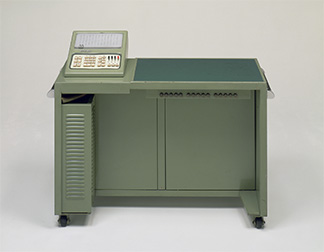
Equipped with relays, the 14-A was the world’s first compact all-electric calculator. In the 1950s, gears were used in office calculators, which took about 10 seconds on average to perform multiplication or division. Furthermore, because the gears were rotated at high speed by electric motor, there was also a noise problem. In order to overcome these issues by developing a calculator based on a completely new concept, the Kashio brothers looked at relays, a technology used by telephone exchanges at that time. Massive computers equipped with 13,000 relays were already in use. With its release in 1957, the 14-A was able to perform the four basic arithmetic operations up to 14 digits using just 341 relays. The Kashio brothers also succeeded in making a calculator that was desk size — small enough to be installed in an office. While gear-type calculators took about 10 seconds to perform multiplication and division, the 14-A took only five to six seconds, and was much quieter. Moreover, the calculators at that time used what was called a “full keypad,” featuring a column of keys (0 to 9) for each of the digit places. The 14-A had just 10 number keys, just like pocket calculators today. Casio had made calculation more efficient and labor-saving, while greatly improving usability.
January 1962
AL-1 programmable scientific calculator
Made technical calculations easier for researchers
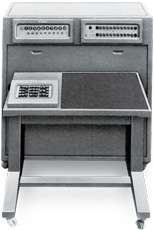
The relay-type computer AL-1 was a scientific calculator with a programming function. By setting a program using six gears, each with 60 teeth, a series of calculations could be performed automatically. In addition, because the six gear units could be removed, multiple calculation routines could be programmed. Due to this ease of use, the AL-1 was popular among many government and university researchers. One reason Casio was able to develop such a useful calculator was the precise feedback it received from researchers during development. These exchanges started with the development of the 14-B, a technical relay-type calculator released in 1959 that featured a square root calculation function. At that time, there were no programmable calculators for advanced technical calculations, and researchers spent a lot of time on computation rather than their primary work. In 2014, the AL-1 was recognized as an important achievement in the history of Japanese science and technology, and was listed on the register of essential historical materials for science and technology (future heritage technology) by the National Museum of Nature and Science in Tokyo.
September 1965
001 electronic desktop calculator
First calculator with a memory function streamlined many calculation tasks
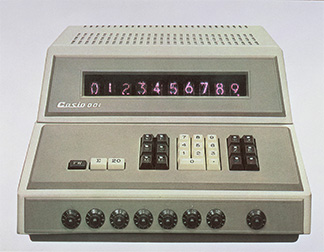
The 001 was born as Casio took on the challenge of developing its first electronic desktop calculator. With an addition and subtraction speed of 0.01 seconds, the 001 was named to reflect Casio’s regret and determination to re-start calculator development in the electronic era from zero. After Casio developed its 14-A relay-type calculator in 1957, it became an industry leader. In 1962, however, a manufacturer in the U.K. announced the world’s first electronic desktop calculator. Japanese manufacturers then began developing electronic calculators in 1964, and the technology started to gain attention. At this point, Casio was still focused on improving its relay calculators. When it came out with a new relay model, the technology direction had already shifted to electronic transistors. Electronic models could be used on the desktop while offering high calculation speeds and silent operation. Realizing that it could only survive as a pure calculator manufacturer by keeping up with the latest product developments customers wanted, Casio decided to begin full-scale electronic calculator development. In addition to accelerating the four basic arithmetic operations, the 001 was equipped with the first seven-digit constant storage dial and memory function in a calculator. The aim was to improve the efficiency of various calculations. The development of convenient features for customers continued, and two years later in 1967, Casio released the world’s first software-type calculator. The AL-1000 enabled calculation routines to be easily input into the memory using the keypad. This is how Casio proved it would be a permanent presence in the calculator market.
August 1972
Casio Mini
World’s first personal calculator made calculation easier for even more people
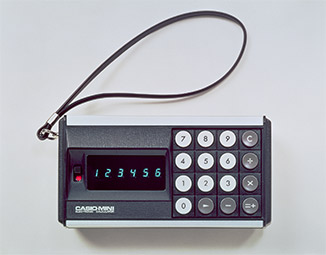
The Casio Mini was a calculator developed for personal use. It was a quarter the size of mainstream models at the time, and at 12,800 yen, it cost just a third of competing products. In those days, a calculator that sold 100,000 units a year was considered a hit, but the Casio Mini became a mega hit, selling one million units in the 10 months after its release. The success of this product represented the end of the fierce “calculator wars” that had been going on among dozens of manufacturers since the late 1960s. One of the ideas for the Casio Mini’s development came from bowling, which had become very popular in Japan. Bowling scores needed to be calculated by hand, and Casio decided to develop a small and affordable calculator for bowling. In addition to creating a six-digit display for home use at a time when the eight-digit display was standard for office calculators, the Casio Mini was realized by developing components especially suited for mass production and the incorporation of large-scale integrated circuits (LSI) for advanced and rapid calculations. The Casio Mini enabled every home to have a calculator and also contributed to the expansion of the calculator market and the development of the semiconductor industry. Subsequent technological advances led to further miniaturization and power saving for calculators. In 1983, Casio launched the SL-800, the world’s slimmest calculator, with a thickness of just 0.8 mm. This credit-card sized calculator is in the permanent collection of the Museum of Modern Art in New York, known as the technological culmination of the effort to streamline and personalize calculators. The Casio Mini and SL-800 were also listed on the register of essential historical materials for science and technology (future heritage technology) by the National Museum of Nature and Science.
May 1974
fx-10 personal scientific calculator
Allowed everyone to calculate functions with ease
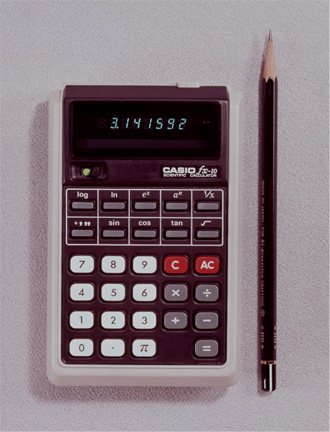
The fx-10 was a pocket-sized personal scientific calculator. In Japan in the early 1970s, scientific calculations were done using computers, the smallest of which was as large as a refrigerator. With a price of one million yen or more, they were not affordable, so most engineers did complex calculations using a simple mechanical device called a slide rule. In 1972, Casio released the fx-1, which could easily perform scientific function calculations. The fx-1 was simple to use and could perform 16 types of function calculations with the touch of a key, making it very popular. Two years later, the fx-10 was released. This was the first LSI-equipped scientific calculator to be made in Japan, and was about one-seventh the weight and roughly one-thirteenth the price of the fx-1. Thanks to 10 keys for performing frequently used functions including trigonometric, exponential, and logarithmic functions, one-key calculation became possible. It was handy to carry around, and enabled engineers to replace the slide rule with their own personal calculator. Thus was born the personal scientific calculator, today widely used around the world.
November 1974
Casiotron QW02 electronic watch
Automatic calendar eliminated the need to reset the date
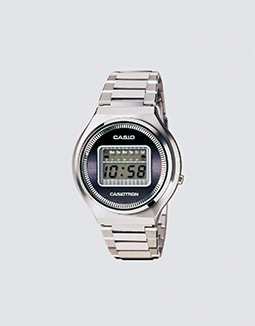
The Casiotron QW02 was the first watch released by Casio. The early 1970s was a period of technological change that saw a switch from mechanical to quartz timepieces. With a solid position in the calculator industry, Casio decided to enter the business field of timepieces. The company realized that by making digital watches, a type of quartz timepiece, it could make the most of the LSI technology it had developed for calculators.
In addition to displaying hours, minutes, and seconds, the QW02 was equipped with the world’s first watch calendar that automatically adjusted for longer and shorter months. With a conventional watch, it was necessary to reset the calendar date on the first of each month, but the QW02 eliminated this hassle. After that, Casio also realized a fully automatic calendar watch that even correctly displayed February 29 during leap years. In 1976, Casio released the X-1. In addition to telling time, the X-1 featured stopwatch and world time functions. Casio went on to develop many more multi-functional digital watches leveraging its digital technology.
January 1980
Casiotone 201 keyboard
Made it possible to play the sounds of various instruments on a keyboard
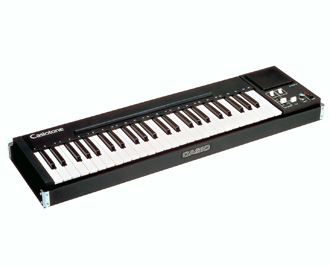
Casio’s electronic musical instrument business began with the electronic keyboard, Casiotone 201. Toshio Kashio, who liked music, thought it would be wonderful to reproduce the beautiful sounds of instruments that are difficult to play, such as the violin, guitar or shakuhachi, using his own hands. In order to make his dream a reality, Toshio developed an unprecedented sound generation system using an approach known as vowel-consonant synthesis. His idea was that sound is basically composed of elements comparable to the consonants and vowels of human speech, and he realized he could combine these two while making subtle changes to create a single sound. As a result, he succeeded in recreating 29 sounds such as piano, cembalo, organ and other keyboard instruments, as well as string instruments such as the harp and koto, and wind instruments like the trumpet and trombone. Previously, the only way to produce the sounds of various instruments had been to learn to play them. With the Casiotone 201, however, anyone could recreate the sounds of these instruments in a natural and pleasing way, using a familiar piano keyboard. This was the starting point of electronic musical instrument development at Casio, which aims to make it easy for anyone to enjoy performing music.
October 1981
TR-2000 English-Japanese electronic dictionary
A frequently used, easy reference tool
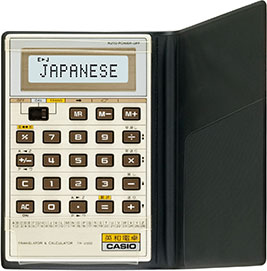
The TR-2000 was Casio’s first electronic dictionary equipped with English-Japanese and Japanese-English dictionaries and a calculation function. Launched in 1981, the TR-2000 had a battery life of up to about 388 hours, and weighed just 53 grams, including batteries. It was equipped with a newly developed large-capacity C-MOS LSI (196 KB/chip), and contained 2,020 English words and phrases, and 1,976 Japanese words. The development of a unique search algorithm enabled high-speed search, which significantly reduced the time to switch between the two languages. Also, by simply sliding a switch, it could also be used as an eight-digit calculator fully equipped with practical calculation functions. The display made it easy to read both English and Japanese text thanks to the adoption of a dot matrix LCD instead of a segment display. It became the new de facto standard that learners reached for when they wanted to look something up or find out the meaning of a word. Business professionals and students carried them in their bags.
November 1981
Casiotone 701 keyboard
Melody Guide enabled people to play music without reading a score
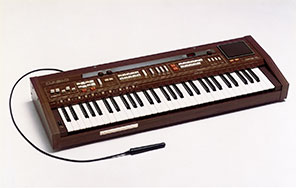
The Casiotone 701 was developed to meet the needs of beginners who wanted to enjoy playing music without having to learn to read it first. Its most remarkable feature was that it could read and store music electronically. This keyboard was the first musical instrument in the world to be equipped with a bar code reader, which was used to read the bar code printed on specially prepared sheet music and save the score in the device. It also had other innovative features not found in conventional musical instruments. It included a Melody Guide function that used built-in LEDs above each key to show the player which key to press next, an automatic performance feature that could play stored songs automatically and allowed one person to sound like an ensemble, and a one-key play feature that enabled people to play chords with just one finger. The Casiotone 701 offered new music playing options not only for beginners, but also for intermediates who had given up because they could not read music. In 1994, the ML-1 was released — the entire key would light up to show the user what to play next. Casio’s desire to allow everyone to easily play a musical instrument was passed down.
April 1983
G-SHOCK DW-5000C
Shock resistant watch overturned the accepted notion of a watch by providing the new value of “toughness”
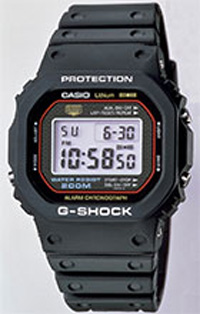
Before G-SHOCK arrived, watches were sensitive instruments that required careful handling. With the release of the DW-5000C, however, Casio overturned that accepted notion, creating new value in the form of a tough, hard-to-break watch. It featured shock and vibration resistance and accurately kept time under various adverse conditions. The watch case was reinforced with a urethane bezel that securely protected the glass and buttons, while the module and other important components inside the watch were also cushioned with shock-absorbing material. Any external impact was mitigated by a total of five protective layers. It also employed a hollow structure to support the module as if it were floating in the case, minimizing impact transmission. The DW-5000C was water resistant to 200 meters. Its performance was praised by firefighters working in harsh conditions, and young people liked having a watch that could be worn without worry while skateboarding. By the mid-1990s, G-SHOCK had become a popular fashion piece for young people. In order to further expand its customer base, Casio then developed the G-SHOCK MRG-100 with full metal watch specifications to appeal to more mature customers. While adhering to the quality of “toughness,” G-SHOCK has continued to evolve in terms of materials and construction. In August 2017, the G-SHOCK brand reached the milestone of 100 million units shipped worldwide. The value offered by the DW-5000C, as a new kind of watch that was tough and difficult to break, continues to be appreciated by countless customers today.
June 1983
TV-10 pocket-type LCD TV
Enabled people to watch TV anytime, anywhere
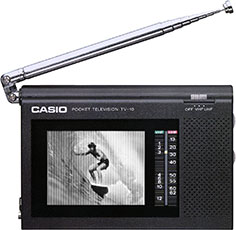
The TV-10 became the world's smallest pocket-type LCD TV in 1983. Televisions had been the king of home appliances since the start of terrestrial TV broadcasting in Japan. However the biggest drawback was that TV could usually only be enjoyed in certain indoor locations. By the 1980s, there were already portable TVs with antennas, but they were not practical due to weight and battery issues. TV-10 was equipped with a newly developed liquid crystal display and high-brightness EL backlight. With a weight of just 335 grams, it was so compact that it could be carried in a pocket. By also offering a choice of four power options, including dry batteries and household power supply, which could be changed according to the situation, users could watch their favorite programs without having to be at certain place at a certain time. Then, in 1992, the CV-1 was released, becoming the world's smallest and lightest color LCD TV. It featured a TFT liquid crystal display with clear contrast and was small enough to fit in a breast pocket. During an era when television was the major source of information and entertainment, this product fulfilled the dreams of people who wanted to watch TV anytime, anywhere.
November 1984
DT-6000 handheld terminal
Made work outside the office easy and efficient
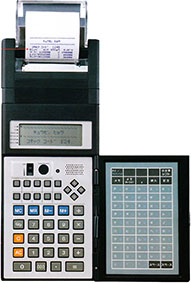
The DT-6000 handheld terminal was a business data processing device that could be held in one hand. A portable data terminal, DT-100, was released by Casio in 1983, one year prior. However, it was A4 size and weighed 1.45 kilograms. With the DT-6000, the width was reduced to about half and the weight to less than a kilogram (860 grams including the printer and battery). By reducing the device size and weight, Casio succeeded in lightening the burden of data input outside the office, while greatly expanding the scope of use. The RAM card format also made it possible to change the operation information just by replacing the program. Data could be exported and utilized. In addition to being able to reference data, the DT-6000 enabled payment processing at the customer site, while order and delivery processing could also be completed on the spot, including data input, recording, storage and transmission. By employing a sheet keyboard format, the device made it possible to enter product names and other information in Japanese or English script, instead of using complicated code numbers. The DT-6000 supported the efficiency of operations outside the office in all types of industries.
November 1984
CZ-101 and CZ-1000 digital synthesizers
PPD Sound Source brought the joy of creating music to even more people
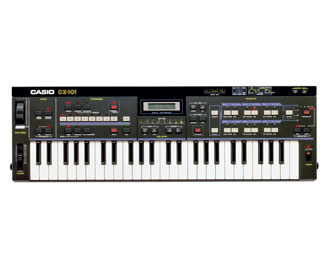
The CZ-101 was a digital synthesizer that could easily create a wide array of sounds. In 1984, synthesizers were used for a variety of music, but they were difficult to operate and expensive, so they were played only by very few musicians and enthusiasts. The CZ-101 employed a newly developed Phase Distortion (PD) Sound Source format. This generated waveforms by distorting the phase (a value indicating the position in the change process) of a sine wave (a curve with periodic oscillation) in various ways. Combining these waveforms made it easy to create many sounds. By employing a small keyboard with 49 keys and a compact appearance, Casio made it easier for musicians to enjoy playing the synthesizer. In 1985, the year after its launch, Casio released the sampling keyboard SK-1. This product made it easy to reproduce various everyday sounds, such as a voice or falling rain, as sound sources, without the need for an expensive sampling machine. Synthesizers and keyboards are different types of instruments, but Casio’s aspiration to allow more people to enjoy the fun of creating sounds remained the same.
August 1985
The fx-7000G, the world’s first graphing scientific calculator
Made it easy to understand difficult mathematical expressions at a glance
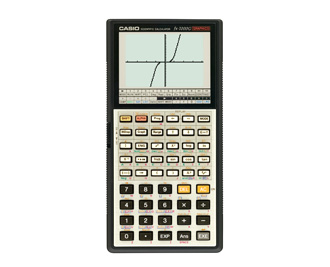
The fx-7000G was the world’s first graphing scientific calculator, which allowed users to understand difficult mathematical expressions visually. Until then, even if you used a scientific or programmable calculator, its role was limited to calculation, and graphing was typically done by hand. The fx-7000G had a large 96 by 64 dot liquid crystal display and was equipped with a function graphing feature. This made it possible to visualize functional expressions that are difficult to understand with only numerical values, such as the slopes of linear equations and the curves of quadratic and cubic equations. The fx-7000G has been recognized for its contribution to mathematics education in the United States and is in the collection of the Smithsonian. In addition, Casio has also been pursuing ease of use for its other scientific calculators without graphing features. The scientific calculator fx-82ES, launched in 2004, aims to help students gain a deeper understanding of mathematics and physics. It features a “natural display” that displays mathematical expressions such as fractions and square roots (√) in the same way as in printed materials. It became popular with students because it enabled them to use formulas written in the same way as in their textbooks.
April 1988
DH-100 digital horn
Made it easy for beginners to have fun
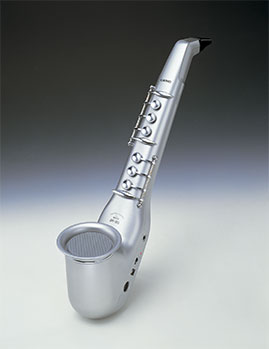
The Digital Horn DH-100 was an electronic wind instrument that let users easily recreate the sound of a wind instrument just by blowing into it. Playing a wind instrument such as saxophone or trumpet requires sophisticated technique such as vibrating the lips, and it requires a lot of practice before the player can make a proper sound. This difficulty was eliminated by the Digital Horn, which enabled the user to produce the proper sound just by blowing into it. In addition to the saxophone and trumpet, customers could also easily produce the sound of the synth reed, oboe, clarinet, and flute. Furthermore, the volume and sound quality could be controlled by the strength of the breath, allowing users to play with the expression unique to wind instruments. The keys were designed to make it feel like playing a wind instrument. For example, it employed the same finger positions as the recorder taught in Japanese elementary schools. With the release of the digital guitars DG-10 and DG-20 in 1987, the aim of the Casio development team remained the same — to further popularize electronic musical instruments and increase the number of musicians.
September 1988
Pocket Word PW-1000 pocket-sized word processor
Featured specialized character input methods
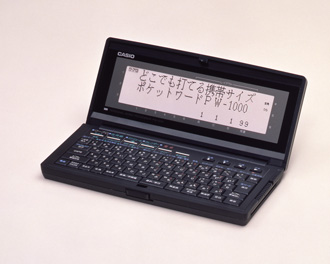
The Pocket Word PW-1000 was a very small personal word processor that could be used easily on the go. In the late 1980s, word processors were being purchased in Japan for the purpose of preparing beautiful documents, and the typing, editing and printing could all be done with one device. As each manufacturer competed to improve editing functions and offer larger screens, Japanese word processors began to get larger and larger. In order to shake up the market, Casio released the compact PW-1000 designed just for text input. There was no floppy disk drive for document storage, and the printer was sold separately. As a compact word processor that could be connected with a desktop word processor, portability was enhanced, and it was small enough to fit into a pocket. Casio had released its first business word processor, the WP-1, in 1981. In addition to a kanji selection method that followed that of Japanese typewriters of the time, the WP-1 offered several other character input methods including a kanji conversion method using kana character input. The result was a business word processor that could be used not only by professional Japanese typists, but also by a wide range of other people. In 1985, Casio released the Word HW-100, its first personal word processor. At that time, kanji conversion could usually only be done by inputting one short phrase at a time. However, the HW-100 offered a method of performing sequential kanji conversion after inputting sentences up to 84 kana characters at once. Casio had advanced its word processor technology to improve usability.
November 1991
Name Land KL-1000 label writer
Made organizing things easier with the power of electronics
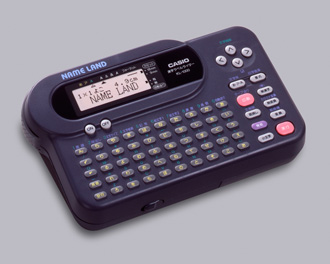
The Name Land KL-1000 was a compact kanji label writer used to easily create labels. Previously, the market offered stamp-type label writers operated by manually turning dials. In 1988, a thermal transfer label writer appeared that could print kanji characters, but text input followed the stamp-type method. Given this situation, the KL-1000 was developed with the aim of allowing people to easily create beautiful labels that included kanji. In addition to the keyboard that made it easy for users to input characters, a specially developed label tape eliminated the need for a protective laminating layer, which had been essential for thermal transfer label writers, thereby improving ease of application by making it thinner. The label tape’s maximum width of 18 mm was perfect for labeling videotapes, which were popular in homes at the time, and many customers used the KL-1000 to make labels for their VCR tapes. The KL-1000 met the user need to organize things more easily through the convenience of electronic technology.
March 1994
NICOTO NP-500 pager
Enabled two-way communication between pagers
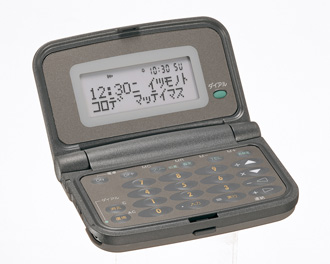
The NICOTO NP-500 brought further innovation to the pager, which was a popular device in the 1990s for receiving messages wirelessly. Until 1994, pagers could only receive numeric messages, specifically, a phone number to call back. The number was input by the sender using a Touch-Tone landline phone, and some users devised a way to send messages using number goroawase (in Japanese, clever pronunciation of a set of numbers can sound similar to a word or phrase: e.g. 0840 = Ohayo or Good Morning). However, this only worked for people who knew how to read them, and it did not work for more complex messages. Addressing this situation, the NICOTO NP-500 was the first pager in the industry to be equipped with a function that could transmit and receive not only numbers but also katakana and alphabetic text. The sender would compose a message on the NP-500, such as “Call the office right away,” and hold the pager to the mouthpiece of the Touch-Tone phone and press a button. Then, the pager would convert and play the message as Touch-Tone signals, so that it could be received and decoded by the destination NP-500. By realizing two-way communication between pagers, the NICOTO NP-500 became a precursor to the text messaging services that arrived with the popular Personal Handy-phone System (PHS) in Japan, and with mobile phones around the world.
March 1995
QV-10 digital camera
LCD screen unlocked the fun of digital photography
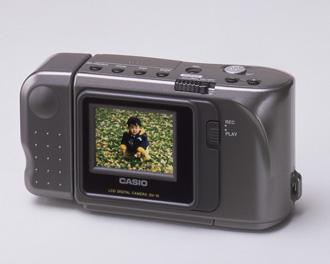
The QV-10 was the world’s first consumer digital camera with an LCD screen. With this revolutionary product, Casio created new value for the digital camera. By removing the optical viewfinder and replacing it with an LCD, Casio transformed the digital camera—which at that time still required that photos be printed to be seen—into much more than just an alternative to the conventional film camera. In addition to allowing captured images to be immediately viewed on the LCD, the camera also had a port for outputting the photos to a TV or VCR for viewing or recording. Images could also be transferred to a computer for processing and storage. By enabling the digital camera to be used in a variety of ways that suited the multimedia era, Casio had come up with a new way to enjoy photo-taking. The QV-10 became a hit product, selling 200,000 units in a year. Leading up to the development of the QV-10 was the VS-101 electronic still camera released in 1987. Developed based on the concept of offering a visual communication tool, the VS-101 was designed to expand the enjoyment of photography by allowing people to capture still images, store them on a floppy disk, and play them back as an analog video signal. This enabled the photos to be viewed on a television and enjoyed by many people. Developed using digital technology, the QV-10 inherited this concept, allowing it to pioneer the digital camera market.
November 1996
CASSIOPEIA A-10 and A-11 handheld PCs
Made information more portable than ever
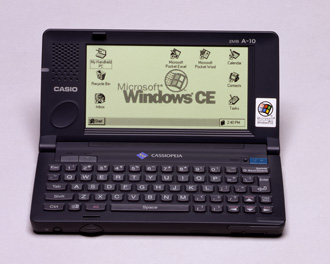
The CASSIOPEIA A-10 and A-11 were the first handheld PCs that Casio jointly developed with Microsoft and released in North America. The handheld PC was a portable information device standardized by Microsoft. In line with the personal computer era that took off with the arrival of Windows 95 in 1995, Casio developed CASSIOPEIA using Windows CE. The concept behind the product development was portable information. This idea had already existed in various Casio products. For example, the electronic organizer PF-3000 released in 1983 could store information such as telephone numbers and alphabetic text. In 1987, Casio released the electronic organizer DK-1000 capable of handling kanji characters. The Databank CD-40 wristwatch, released in 1984, was equipped with a feature that could store 10 telephone numbers. Casio was already working to advance the watch as an information device on the wrist. In 1993, the Z-7000 personal digital assistant (PDA) was launched. These were the developments that led up to the CASSIOPEIA.
February 2000
G'zOne C303CA cdmaOne-compatible cellular phone
Delivered unprecedented product “toughness” for a wide range of usage situations
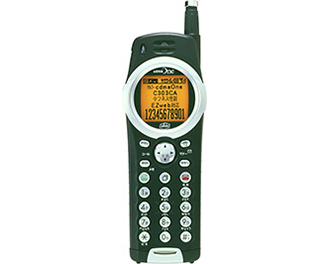
The G'zOne was a cellular phone with water and shock resistance. In 2000, Casio was the last of various Japanese manufacturers to enter the cellular phone market. Therefore, in order to make use of its unique strengths, just like it did for G-SHOCK, Casio pursued development based the concept of offering thorough product “toughness” and enhancing basic usability as much as possible. Casio’s first mobile phone, the C303CA, gained popularity especially among young people, because it could be used with confidence in the rain, or under other harsh conditions found in everyday life. Because of its “toughness” that made it hard to break, the G'zOne was perfect for all kinds of conditions. As a result, the product was also appreciated by people spending a lot of time outside, including outdoor enthusiasts, motorcycle delivery drivers, and construction workers, and was used for many years.
November 2001
WVA-300 solar-powered radio-controlled watch
Powered by light and continually showed the correct time
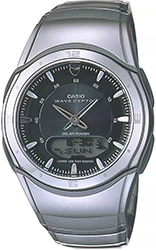
The Wave Ceptor WVA-300 was a solar-powered radio-controlled watch that could automatically sync itself to the correct time by receiving standard time radio signals. In other words, wearers could always know the correct time without having to adjust the watch manually. Since it was also solar powered, it offered the convenience of not needing battery replacement (except for eventual replacement of the rechargeable battery). Casio had long been working on improving basic watch performance including accuracy, battery life and ease of use. It had been pursuing this since the launch of the Casiotron, which offered an automated calendar, based on a development concept for a fully automatic watch. The same was true for radio-controlled watches. After Casio’s first radio-controlled watch, the FKT-100L, released in Europe in 1995, came the WVA-300 released worldwide in 2001, and The G, launched worldwide as a solar-powered radio-controlled G-SHOCK the following year. In 2008, Casio released a G-SHOCK with the world’s first Multi Band 6 radio wave receiver system. Casio has continually pursued radio-controlled watches that wearers can use with confidence.
June 2002
EXILIM EX-S1 card-size digital camera
Epitomized the concept of less is more
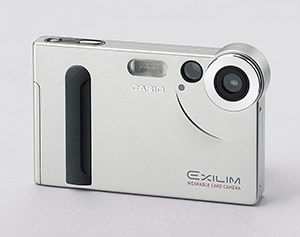
The EXILIM EX-S1 was a digital camera developed based on the novel concept of a “wearable card camera” that is with you wherever you go. By the early 2000s, the transition from film to digital cameras was in full progress. Casio developed the EX-S1 as part of its continual pursuit of value through digital technology. The camera’s most remarkable feature was its card size for amazing portability, and its instant startup enabling photo-taking just one second after activation. It was not equipped with a zoom, and the focus was fixed. By limiting the number of pixels to 1.24 million, and installing only the essential functions, the emphasis was placed on compact size and usability. This approach of pursuing the value inherent to digital cameras also supported subsequent product development. Launched in 2008, the EX-F1 provided ultra-fast continuous shooting of 60 images per second, and offered the joy of capturing moments that cannot be seen with the naked eye. Two years later, the EX-ZR10 was released and offered High Dynamic Range (HDR), based on high-speed continuous shooting. This feature was only possible with digital technology and offered the fun of creating and sharing artistic photographs. After releasing these products, Casio focused on developing cameras with high-speed image processing engines, and went on to deliver models that encouraged spontaneous image capturing and that continued to provide enjoyment even after photos had been taken.
October 2003
Privia PX-100 digital piano
A serious instrument with style and affordability
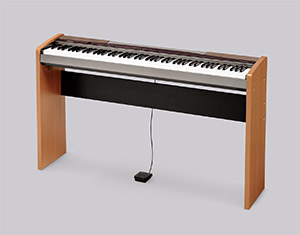
The Privia PX-100 was a digital piano that closely resembled the feel and tone of a grand piano while being compact enough to fit in almost any location. The name “Privia” was coined by blending the words, “Private Piano.” It had a stylish design targeting young women, and was named based on the concept of a digital piano that can fit in a bedroom or small apartment. Casio had previously released two full-fledged digital pianos (AP-7 and AP-5) in 1991, and developed them as part of the CELVIANO series. In 2003 however, fully-equipped electronic pianos like a CELVIANO usually cost over 100,000 yen. The PX-100 offered a slim profile, a heavier touch from keys in the bass range and a lighter touch from keys in the treble range, and an expressive timbre that carefully reproduced the sound of a concert grand piano. The result was a digital piano with improved quality, yet at a price and weight about half that of conventional models, which became widely popular. In 2015, the CELVIANO Grand Hybrid GP-500BP and GP-300BK, which had a sound source jointly developed with C. Bechstein, were released for pianists who wanted an even higher level of piano performance. By producing electronic pianos that meet various needs, Casio has been expanding the range of people who enjoy performing music. This includes children who want to try learning piano, adults who want to discover the fun of playing piano, and also those who are serious about becoming performers.
March 2004
EX-word XD-L4600
A tough shock-resistant electronic dictionary made for high school students
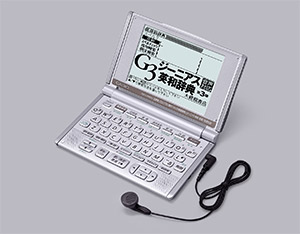
The XD-L4600 was an electronic dictionary developed mainly for high school students in Japan, and it featured rugged, shock-resistant construction. The motivation behind its development was a desire to create an electronic dictionary that high school students could use with confidence. The history of the EX-word series of electronic dictionaries began with the XD-500 in 1996. However, it did not become popular with high school students until around 2001, when the Classical Japanese dictionary model was released. Unfortunately, a significant number of high school students reported accidentally damaging their dictionaries. It turned out that high school students tended to handle their electronic devices more roughly than anticipated. Casio needed to make an electronic dictionary better suited for teenagers that was shock-resistant and hard to break even if dropped. Consequently, the robust XD-L4600 was designed with Totally Advanced Force Control Technology (TAFCOT). In 2005, the following year, Casio came out with the XD-LP4600 electronic dictionary. It featured a massive number of dictionary entries with an English native speaker’s correct and natural pronunciation of the English words, using Casio’s original True Voice technology. Casio further advanced the field of electronic dictionaries by aiming to deliver products ever more useful for learning, while maintaining toughness.
August 2007
TE-2500 and TK-2500 Internet-ready registers
Enabled streamlined sales management operations based on a concept that anticipated the cloud era
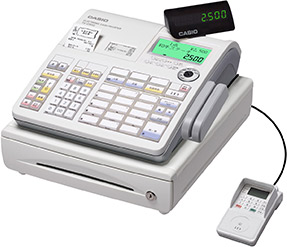
The TE-2500 and TK-2500 were Internet-ready electronic registers that could be connected directly to the Internet thanks to a built-in Virtual Private Network (VPN) function. Direct access to the Internet enabled shop owners to immediately grasp the latest sales information online from one or more shop locations. Unlike the POS system at the time, which was used by large retail chains, by eliminating the need for a computer to perform tabulation, or a dedicated data communication line, the new models made it possible to streamline sales management operations for multiple stores. As a result, the TE-2500 and TK-2500 became popular with small and medium-sized retailers and restaurants that were not large enough to need a POS system. The concept of supporting store efficiency had not wavered since Casio’s first electronic register, the Σ-50ER, released in 1976. The TE-2500 and TK-2500 were equipped with a function to handle information in a cloud-like manner, even before the concept of cloud computing became mainstream, and they helped to streamline sales management operations.
April 2010
Green Slim Projector XJ-A145
World’s first projector equipped with a new mercury-free, high-brightness light source
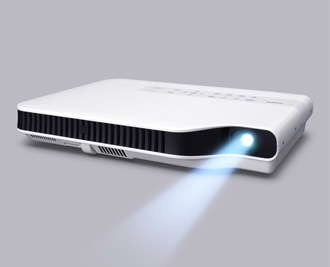
The Green Slim Projector was the world’s first mercury-free, high-brightness data projector. Being mercury-free had two benefits. First, there was no need for users to dispose of harmful mercury lamps, and because the new light source had a long lifespan, it reduced the environmental impact caused by conventional lamp replacement. With the mercury-free technology, start-up was also faster, and there was no need to let the projector cool down after use. The second benefit was that the Green Slim Projector offered the value of being always ready to use, like a television. In 2010, it was commonly thought in the industry that a high brightness of over 2,000 lumens was not feasible without using a mercury lamp. Casio, which entered the business projector market in 2003, also used mercury lamps until it developed the Green Slim Projector. Yet Casio aspired to develop a next-generation projection light source. This was based on the concept of “clean & green,” and Casio sought to achieve both a mercury-free solution and high luminance. Casio succeeded in developing a unique hybrid light source combining laser and LED technologies, delivering both environmental performance and high brightness.
April 2011
EXILIM EX-TR100
A freestyle camera that evolved into a dedicated selfie device
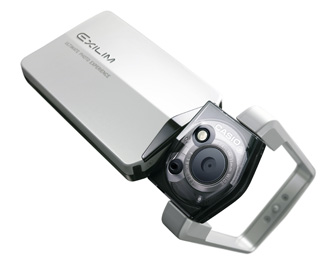
The EXILIM EX-TR100 was a digital camera developed with the concept of freestyle shooting. Its most outstanding feature was a movable frame design that clearly set it apart from previous digital cameras. The frame could be rotated 360 degrees around the lens and screen, and the screen could also swivel 270 degrees. In addition to being extremely portable, it enabled users to capture photos and movies by positioning the camera on a desk or wall, and could be held many different ways. It was first was released in North America as a model named TRYX. After a popular Hong Kong fashion model uploaded photos she had taken of herself with the EX-TR100 to a social media site, it began to be known as a camera that could capture beautiful face shots. It subsequently became a big hit among women in China and Southeast Asia, and was described in Chinese as a “goddess selfie device.” After that, the EX-TR100 was developed into the TR series of cameras designed for selfie taking. Such unique product development originated from Casio’s desire to expand the way people enjoy digital cameras — a motivation that had remained since the launch of the QV-10. The EXILIM EX-FR10 was then released in 2014. It was a camera where the lens and screen could be completely separated, overturning conventional camera positioning when taking a picture. This new form of freestyle shooting further expanded the way a camera could be enjoyed.
July 2014
G-SHOCK GPW-1000
Provided accurate timekeeping even in harsh environments
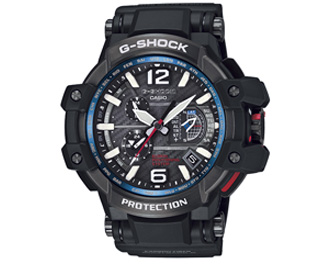
The G-SHOCK GPW-1000 was a wristwatch equipped with the world’s first hybrid time acquisition system that could perform time syncing using both Multi-Band 6 radio and GPS satellite signals. The most outstanding feature of this product was its ability to provide the exact time even in some of the harshest environments around the world. A conventional radio-controlled watch automatically syncs to the correct time using standard radio signals that include time information. The GPW-1000 displayed the correct time anywhere in the world using an additional and complementary time acquisition system that received GPS signals from satellites. This meant it worked even in regions outside the reach of terrestrial time signal transmitters. Also, by incorporating high-precision map data into the watch, it could use GPS positioning information to determine the wearer’s time zone and daylight saving status in order to display the correct time. Earlier, Casio had launched the world’s first watch with built-in GPS, the PRT-1GPJ, in 1999. In addition to being equipped with location positioning and other features for outdoor use, it could display the correct time by receiving GPS signals. The technology at that point, however, had issues such as device size and battery life. The GPW-1000 became the culmination of Casio’s determination to enhance the lives of customers by ensuring they could always know the correct time no matter where they were.
March 2016
Smart Outdoor Watch WSD-F10
Made for enjoying outdoor activities with a tough information device on your wrist
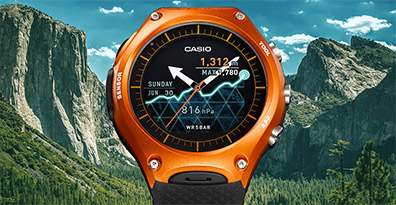
The Smart Outdoor Watch WSD-F10 was the optimal wrist device for outdoor activities. It was waterproof to ensure performance during water activities or in the rain, and it even met a U.S. military procurement standard for withstanding drops and vibration. Its best feature was its design for outdoor use. In situations where it is difficult to use a smartphone, the need for a wrist device increases. In addition to various apps that are useful in outdoor pursuits such as trekking, cycling, and fishing, the watch also came installed with original apps to measure changes in the natural environment or the level of the wearer’s physical activity using built-in sensors. Since it utilized the Android Wear operating system, wearers could also add apps to further enhance functionality for different outdoor situations. Since the 1980s, Casio had developed many multifunction digital watches that have provided information for exercise and outdoor activities. These watches include the JP-100, which supported joggers with a pulse measurement feature, and the BM-100, which could forecast the weather by using a sensor to detect changes in barometric pressure. Inheriting Casio’s accumulated expertise, the WSD-F10 provided wearers with a wrist device for fully enjoying outdoor life.





























